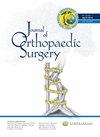拇外翻微创截骨术后三种不同固定方式截骨端生物力学三维有限元分析。
IF 1.6
4区 医学
Q3 ORTHOPEDICS
引用次数: 0
摘要
目的:采用有限元技术对拇外翻后微创截骨固定方法进行生物力学研究尚未见报道。本研究旨在比较微创截骨术采用绷带、克氏针、赫伯特螺钉固定后截骨末端的最大位移和应力分布。方法:收集1例轻中度拇外翻患者足部CT图像。通过CT图像建立拇外翻的三维有限元模型。本研究模拟绷带、克氏针和赫伯特螺钉固定,分析固定后足跖屈曲位置截骨端最大位移和应力分布。结果:绷带、克氏针、赫伯特螺钉固定截骨端最大等效应力分别为7.8615、14.253、8.3156 MPa。绷带、克氏针、赫伯特螺钉固定截骨端总位移分别为0.26,896、0.022,779、0.029,195 mm。截骨端附近克氏针和赫伯特螺钉的最大应力分别为154.7和46.404 MPa。克氏针和赫伯螺钉的固定强度和稳定性优于绷带。克氏针存在应力集中现象,有断裂的潜在危险。赫伯特螺钉应力在截骨端周围分布均匀,存在一定的应力集中,对维持骨折端稳定起重要作用。结论:Herbert螺钉具有良好的固定强度和稳定性,应力分布均匀,能很好地维持微创截骨末端的稳定性。本研究结果可为临床上微创拇外翻截骨术后固定方式的选择提供理论依据。本文章由计算机程序翻译,如有差异,请以英文原文为准。
Three dimensional finite element analysis of biomechanics of osteotomy ends with three different fixation methods after hallux valgus minimally invasive osteotomy.
PURPOSE Biomechanical study of fixation methods post hallux valgus minimally invasive osteotomy using finite element technology hasn't been reported. This study aimed to compare maximum displacement and stress distribution of osteotomy ends after minimally invasive osteotomy fixed by bandage, Kirschner wire, Herbert screw. METHODS Foot CT images of a patient with mild-moderate hallux valgus were collected. Three-dimensional finite element model of hallux valgus was established through CT image. This study simulated bandage, Kirschner wire and Herbert screw fixation, and analyzed maximum displacement and stress distribution of osteotomy ends in plantar flexion position of foot after fixation. RESULTS Maximum equivalent stress of osteotomy end fixed with bandage, Kirschner wire, Herbert screw was 7.8615, 14.253, 8.3156 MPa, respectively. Total displacement of osteotomy end fixed by bandage, Kirschner wire, Herbert screw was 0.26,896, 0.022,779, 0.029,195 mm, respectively. Maximum stress of Kirschner wire and Herbert screw near osteotomy end was 154.7 and 46.404 MPa, respectively. Fixation strength and stability of Kirschner wire and Herber screw were better than bandage. Kirschner wire had stress concentration phenomenon, with potential fracture risk. Stress of Herbert screw was evenly distributed around osteotomy end, and there was a certain stress concentration, playing an important role in maintaining fracture end stability. CONCLUSIONS Herbert screw showed good fixation strength and stability, and stress distribution was uniform, which can well maintain stability of minimally invasive osteotomy ends. Findings of this study would provide a theoretical basis for selection of fixation methods after clinical minimally invasive osteotomy for hallux valgus.
求助全文
通过发布文献求助,成功后即可免费获取论文全文。
去求助
来源期刊

Journal of Orthopaedic Surgery
ORTHOPEDICS-SURGERY
CiteScore
3.10
自引率
0.00%
发文量
91
审稿时长
13 weeks
期刊介绍:
Journal of Orthopaedic Surgery is an open access peer-reviewed journal publishing original reviews and research articles on all aspects of orthopaedic surgery. It is the official journal of the Asia Pacific Orthopaedic Association.
The journal welcomes and will publish materials of a diverse nature, from basic science research to clinical trials and surgical techniques. The journal encourages contributions from all parts of the world, but special emphasis is given to research of particular relevance to the Asia Pacific region.
 求助内容:
求助内容: 应助结果提醒方式:
应助结果提醒方式:


